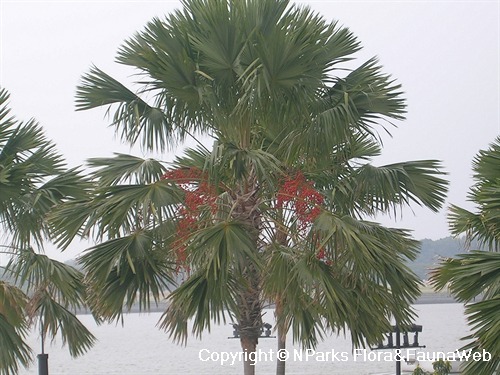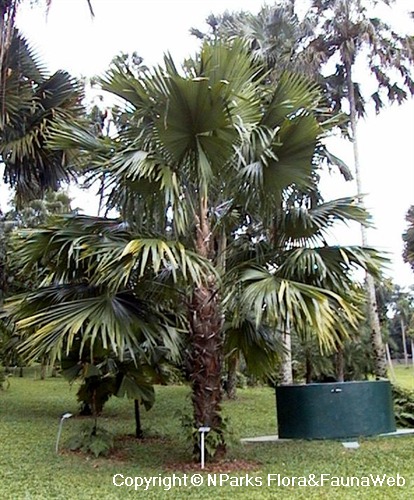
Back
Saribus rotundifolius (Lam.) Blume
| Family Name: | Arecaceae (Palmae) |
| Synonyms: | Livistona rotundifolia (Lam.) Mart., Livistona altissima Zoll., Livistona mircocarpa Becc., Livistona mindorensis Becc., Livistona robinsoniana Becc., Corypha rotundifolia Lam., Licuala rotundifolia (Lam.) Blume in J.J. Roemer & J.A. Schultes |
| Common Name: | Footstool Palm, Java Palm, Sadeng, Serdang, Fan Palm, Anahaw Palm |
Name
Classifications and Characteristics
| Plant Division | Angiosperms (Flowering Seed Plants) |
|---|---|
| Plant Growth Form | Palm (Solitary Habit) |
| Lifespan (in Singapore) | Perennial |
| Mode of Nutrition | Autotrophic |
| Plant Shape | Fountain (Palm-like) |
| Maximum Height | 18 m to 27 m |
Biogeography
| Native Distribution | From Borneo to New Guinea |
|---|---|
| Native Habitat | Terrestrial (Primary Rainforest) |
| Preferred Climate Zone | Tropical |
| Local Conservation Status | Non-native (Spontaneous (Casual)) |
Description and Ethnobotany
| Growth Form | It is a tall palm with a solitary stem, growing to about 18–27m tall. |
|---|---|
| Foliage | Its long-stalked, spirally arranged palmate leaves have leaf blades that are almost round in outline, and regularly divided to about half of the length, 1.2m in diameter. |
| Flowers | Its flowers are borne on a long-stalked inflorescence, about 0.9–1.2m long. |
| Fruit | Its round fruits are fleshy drupes that are about 2cm across, ripening from red to black. |
| Associated Fauna | Its flowers are pollinated by bees. Its fruits are eaten by frugivorous birds. |
| Cultivation | It can be propagated from seed. |
| Etymology | Latin, Saribus, from the Maluku vernacular name, sariboe; Latin rotundifolius, having rounded leaves, referring to the almost round palmate leaves. |
| Ethnobotanical Uses | Others: It is commonly cultivated as a ornamental plant. |
Landscaping Features
| Landscaping | It is suitable for growing along streetscapes, and in parks and gardens for its attractive round leaves, and ornamental fruits. |
|---|---|
| Desirable Plant Features | Ornamental Foliage, Ornamental Fruits |
| Landscape Uses | Suitable for Roadsides, Parks & Gardens |
Fauna, Pollination and Dispersal
| Fauna Pollination Dispersal Associated Fauna | Bird-Attracting |
|---|---|
| Pollination Method(s) | Biotic (Fauna) |
| Seed or Spore Dispersal | Biotic (Fauna) |
Plant Care and Propagation
| Light Preference | Full Sun |
|---|---|
| Water Preference | Moderate Water |
| Plant Growth Rate | Moderate |
| Rootzone Tolerance | Moist Soils, Well-Drained Soils, Fertile Loamy Soils |
| Propagation Method | Seed |
Foliar
| Foliage Retention | Evergreen |
|---|---|
| Mature Foliage Colour(s) | Green |
| Foliar Type | Compound (Palmate) |
| Foliar Arrangement Along Stem | Spiral |
| Foliar Attachment to Stem | Petiolate |
| Foliar Shape(s) | Palm Fronds (Fan / Costapalmate) |
| Foliar Venation | Parallel |
| Leaf Area Index (LAI) for Green Plot Ratio | 2.5 (Palm - Solitary) |
Non - Foliar and Storage
| Trunk Type (Palm) | Solitary Habit, Aboveground |
|---|
Floral (Angiosperm)
| Flower & Plant Sexuality | Bisexual Flowers |
| Flower Colour(s) | Cream / Off-White |
|---|---|
| Flower Grouping | Cluster / Inflorescence |
| Flower Location | Axillary |
Fruit, Seed and Spore
| Mature Fruit Colour(s) | Red, Black |
|---|---|
| Fruit Classification | Simple Fruit |
| Fruit Type | Fleshy Fruit , Non-Accessory Fruit |
Image Repository
Others
| Master ID | 1360 |
|---|---|
| Species ID | 2653 |
| Flora Disclaimer | The information in this website has been compiled from reliable sources, such as reference works on medicinal plants. It is not a substitute for medical advice or treatment and NParks does not purport to provide any medical advice. Readers should always consult his/her physician before using or consuming a plant for medicinal purposes. |

